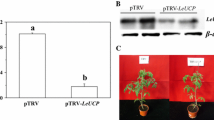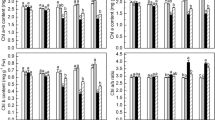Abstract
Mitochondrial uncoupling proteins play important roles in generation of metabolic thermogenesis, response to stress situations, and regulation of energy metabolism. We demonstrated here that the absence of LeUCP in tomato inhibited photosynthesis using virus-induced gene-silencing approach. A significant decrease in the rate of CO2 assimilation in LeUCP-silencing plants was observed over a range of different light intensities. Absence of LeUCP resulted in lower net photosynthetic rate, light-saturated rate of the CO2 assimilation (A sat), maximum carboxylation rates (V cmax) and maximum RuBP regeneration rate (J max). Activities of ribulose-1,5-bisphosphate carboxylase/oxygenase Rubisco and stromal fructose-1,6-bisphosphatase and genes expression levels encoded Calvin cycle enzymes of LeUCP gene-silencing plants were inhibited. However, silencing of LeUCP gene had no effect on F v/F m, but decreased photochemical quenching and electron transport rate. Meanwhile, non-photochemical quenching and Je (PSII), the distribution of Je (PCR) and Je (PCO), the content of AsA, NAD, and the ratios of NAD+/NADH, AsA/DHA were significantly reduced with increased reactive oxygen species while GSH and GSSG were unaltered. Taken together, these results strongly suggest that LeUCP gene in tomato leaves is crucial in maintaining the redox poise of the mitochondrial electron transport chain to facilitate photosynthetic metabolism.








Similar content being viewed by others
References
Allen DJ, Ort DR (2001) Impacts of chilling temperatures on photosynthesis in warm-climate plants. Trends Plant Sci 6:36–42
Apel K, Hirt H (2004) Reactive oxygen species: metabolism, oxidative stress, and signal transduction. Annu Rev Plant Biol 55:373–399
Baker NR, Rosenqvist E (2004) Applications of chlorophyll fluorescence can improve crop production strategies: an examination of future possibilities. J Exp Bot 55:1607–1621
Begcy K, Mariano ED, Mattiello L, Nunes AV, Mazzafera P, Maia IG, Menossi M (2011) An Arabidopsis mitochondrial uncoupling protein confers tolerance to drought and salt stress in transgenic tobacco plants. PLoS ONE 6:e23776
Bestwick CS, Brown IR, Bennett MHR, Mansfield JW (1997) Localization of hydrogen peroxide accumulation during the hypersensitive reaction of lettuce cells to Pseudomonas syringae pv phaseolicola. Plant Cell 9:209–221
Borecky J, Vercesi AE (2005) Plant uncoupling mitochondrial protein and alternative oxidase: energy metabolism and stress. Bioscience Rep 25:271–286
Buchanan BB, Balmer Y (2005) Redox regulation: a broadening horizon. Annu Rev Plant Biol 56:187–220
Chen JC, Jiang CZ, Gookin TE, Hunter DA, Clark DG, Reid MS (2004) Chalcone synthase as a reporter in virus-induced gene silencing studies of flower senescence. Plant Mol Biol 55:521–530
Cui JX, Zhou YH, Ding JG, Xia XJ, Shi K, Chen SC, Asami T, Chen ZX, Yu JQ (2011) Role of nitric oxide in hydrogen peroxide-dependent induction of abiotic stress tolerance by brassinosteroids in cucumber. Plant, Cell Environ 34:347–358
Dai AH, Nie YX, Yu B, Li Q, Lu LY, Bai JG (2012) Cinnamic acid pretreatment enhances heat tolerance of cucumber leaves through modulating antioxidant enzyme activity. Environ Exp Bot 79:1–10
Dietz KJ (2008) Redox signal integration: from stimulus to networks and genes. Physiol Plant 133:459–468
Dietz K-J, Pfannschmidt T (2011) Novel Regulators in photosynthetic redox control of plant metabolism and gene expression. Plant Physiol 155:1477–1485
Doulis AG, Debian N, Kingston-Smith AH, Foyer CH (1997) Differential localization of antioxidants in maize leaves. Plant Physiol 114:1031–1037
Elstner EF, Heupel A (1976) Inhibition of nitrite formation from hydroxylammonium-chloride—simple assay for superoxide dismutase. Anal Biochem 70:616–620
Ethier GJ, Livingston NJ (2004) On the need to incorporate sensitivity to CO2 transfer conductance into the Farquhar-von Caemmerer-Berry leaf photosynthesis model. Plant, Cell Environ 27:137–153
Filella I, Llusia J, Pinol J, Penuelas J (1998) Leaf gas exchange and fluorescence of Phillyrea latifolia, Pistacia lentiscus and Quercus ilex saplings in severe drought and high temperature conditions. Environ Exp Bot 39:213–220
Foyer CH, Theodoulou FL, Delrot S (2001) The functions of inter- and intracellular glutathione transport systems in plants. Trends Plant Sci 6:486–492
Harbinson J, Genty B, Foyer CH (1990) Relationship between photosynthetic electron-transport and stromal enzyme-activity in pea leaves—toward an understanding of the nature of photosynthetic control. Plant Physiol 94:545–553
Jabs T, Dietrich RA, Dangl JL (1996) Initiation of runaway cell death in an Arabidopsis mutant by extracellular superoxide. Science 27:1853–1856
Jarmuszkiewicz W, Woyda-Ploszczyca A, Antos-Krzeminska N, Sluse FE (2010) Mitochondrial uncoupling proteins in unicellular eukaryotes. BBA Bioenerg 1797:792–799
Jezek P, Hanus J, Semrad C, Garlid KD (1996) Photoactivated azido fatty acid irreversibly inhibits anion and proton transport through the mitochondrial uncoupling protein. J Biol Chem 271:6199–6205
Krauss S, Zhang CY, Lowell BB (2005) The mitochondrial uncoupling-protein homologues. Nat Rev Mol Cell Bio 6:248–261
Law MY, Charles SA, Halliwell B (1983) Glutathione and ascorbic-acid in spinach (Spinacia oleracea) chloroplasts—the effect of hydrogen-peroxide and of Paraquat. Biochem J 210:899–903
Lilley RM, Walker DA (1974) An improved spectrophotometric assay for ribulose-bisphosphate carboxylase. Biochim Biophys Acta 358:226–229
Liu YL, Schiff M, Dinesh-Kumar SP (2002) Virus-induced gene silencing in tomato. Plant J 31:777–786
Livak KJ, Schmittgen TD (2001) Analysis of relative gene expression data using real-time quantitative PCR and the 2-ΔΔCT method. Methods 25:402–408
Maia IG, Benedetti CE, Leite A, Turcinelli SR, Vercesi AE, Arruda P (1998) AtPUMP: an Arabidopsis gene encoding a plant uncoupling mitochondrial protein. FEBS Lett 429:403–406
Maxwell DP, Nickels R, McIntosh L (2002) Evidence of mitochondrial involvement in the transduction of signals required for the induction of genes associated with pathogen attack and senescence. Plant J 29:269–279
Meyer Y, Buchanan BB, Vignols F, Reichheld JP (2009) Thioredoxins and glutaredoxins: unifying elements in redox biology. Annu Rev Genet 43:335–367
Miyake C, Yokota A (2000) Determination of the rate of photoreduction of O2 in the water-water cycle in watermelon leaves and enhancement of the rate by limitation of photosynthesis. Plant Cell Physiol 41:335–343
Noctor G, Foyer CH (1998) Ascorbate and glutathione: keeping active oxygen under control. Annu Rev Plant Physiol Plant Mol Biol 49:249–279
Nogueira FTS, Sassaki FT, Maia IG (2011) Arabidopsis thaliana Uncoupling Proteins (AtUCPs): insights into gene expression during development and stress response and epigenetic regulation. J Bioenerg Biomembr 43:71–79
Oswald O, Martin T, Dominy PJ, Graham IA (2001) Plastid redox state and sugars: interactive regulators of nuclear-encoded photosynthetic gene expression. Proc Natl Acad Sci USA 98:2047–2052
Ozawa K, Murayama S, Kobayashi-Uehara A, Handa H (2006) Overexpression of wheat mitochondrial uncoupling protein in rice plants confers tolerances to oxidative stresses promoted by exogenous hydrogen peroxide and low temperature. Mol Breed 18:51–56
Perez-Lopez U, Robredo A, Lacuesta M, Sgherri C, Mena-Petite A, Navari-Izzo F, Munoz-Rueda A (2010) Lipoic acid and redox status in barley plants subjected to salinity and elevated CO2. Physiol Plantarum 139:256–268
Pfannschmidt T, Braeutigam K, Wagner R, Dietzel L, Schroeter Y, Steiner S, Nykytenko A (2009) Potential regulation of gene expression in photosynthetic cells by redox and energy state: approaches towards better understanding. Ann Bot 103:599–607
Pignocchi C, Fletcher JE, Barnes J, Foyer CH (2003) The function of ascorbate oxidase (AO) in tobacco (Nicotiana tabacum L.). Plant Physiol 132:1631–1641
Popov VN, Eprintsev AT, Maltseva EV (2011) Activation of genes encoding mitochondrial proteins involved in alternative and uncoupled respiration of tomato plants treated with low temperature and reactive oxygen species. Russ J Plant Physiol 58:914–920
Rao MV, Ormrod DP (1995) Impact of UVB and O3 on the oxygen-free radical scavenging system in Arabidopsis thaliana genotypes differing in flavonoid biosynthesis. Photochem Phorobiol 62:719–726
Ryrie IJ, Scott KJ (1968) Metabolic regulation in diseased leaves II. changes in nicotinamide nucleotide coenzymes in barley leaves infected with powdery mildew. Plant Physiol 43:687–692
Scheibe R, Fickenscher K, Ashton AR (1986) Studies on the mechanisms of the reductive activation of NADP-malate dehydrogenase by thioredoxin m and low molecular weight thiols. Biochim Biophys Acta 870:191–197
Schonhof I, Kläring HP, Krumbein A, Clau beta ben W, Schreiner M (2007) Effect of temperature increase under low radiation conditions on phytochemicals and ascorbic acid in greenhouse grown broccoli. Agr Ecosyst Environ 119:103–111
Sharkey TD, Savitch LV, Butz ND (1991) Photometric method for routine determination of kcat and carbamylation of Rubisco. Photosynth Res 28:41–48
Shi K, Dine XT, Dong DK, Zhou YH, Yu JQ (2008) Putrescine enhancement of tolerance to root-zone hypoxia in Cucumis sativus: a role for increased nitrate reduction. Funct Plant Biol 35:337–345
Sluse F, Jarmuszkiewicz W, Navet R, Douete P, Mathy G, Sluse-Goffart CM (2006) Mitochondrial UCPs: new insights into regulation and impact. BBA Bioenerg 5–6:480–485
Smith AMO, Ratcliffe RG, Sweetlove LJ (2004) Activation and function of mitochondrial uncoupling protein in plants. J Biol Chem 279:51944–51952
Sonoike K (2011) Photoinhibition of photosystem I. Physiol Plantarum 142(1):56–64
Sweetlove LJ, Lytovchenko A, Morgan M, Nunes-Nesi A, Taylor NL, Baxter CJ, Eickmeier I, Fernie AR (2006) Mitochondrial uncoupling protein is required for efficient photosynthesis. Proc Natl Acad Sci USA 103:19587–19592
Swidzinski JA, Sweetlove LJ, Leaver CJ (2002) A custom microarray analysis of gene expression during programmed cell death in Arabidopsis thaliana. Plant J 30:431–446
Talbot DA, Brand MD (2005) Uncoupling protein 3 protects aconitase against inactivation in isolated skeletal muscle mitochondria. Biochim Biophys Acta 1709:150–156
Thordal-Christensen H, Zhang ZG, Wei YD, Collinge DB (1997) Subcellular localization of H2O2 in plants: H2O2 accumulation in papillae and hypersensitive response during the barley-powdery mildew interaction. Plant J 11:1187–1194
Trono D, Flagella Z, Laus MN, Di Fonzo N, Pastore D (2004) The uncoupling protein and the potassium channel are activated by hyperosmotic stress in mitochondria from durum wheat seedlings. Plant Cell Environ 27:437–448
Vercesi AE, Borecky J, Godoy Maia ID, Arruda P, Cuccovia IM, Chaimovich H (2006) Plant uncoupling mitochondrial proteins. Ann Rev Plant Biol 57:383–404
von Caemmerer S, Farquhar GD (1981) Some relationships between the biochemistry of photosynthesis and the gas exchange of leaves. Planta 153:376–387
Willekens H, Chamnongpol S, Davey M, Schraudner M, Langebartels C, VanMontagu M, Inze D, VanCamp W (1997) Catalase is a sink for H2O2 and is indispensable for stress defence in C3 plants. EMBO J 16:4806–4816
Wullschleger SD (1993) Biochemical limitations to carbon assimilation in C3 plants—a retrospective analysis of the A/Ci curves from 109 species. J Exp Bot 44:907–920
Xia XJ, Huang LF, Zhou YH, Mao WH, Shi K, Wu JX, Asami T, Chen ZX, Yu JQ (2009a) Brassinosteroids promote photosynthesis and growth by enhancing activation of Rubisco and expression of photosynthetic genes in Cucumis sativus. Planta 230:1185–1196
Xia XJ, Wang YJ, Zhou YH, Tao Y, Mao WH, Shi K, Asami T, Chen ZX, Yu JQ (2009b) Reactive oxygen species are involved in Brassinosteroid-induced stress tolerance in cucumber. Plant Physiol 150:801–814
Yosef I, Irihimovitch V, Knopf JA, Cohen I, Orr-Dahan I, Nahum E, Keasar C, Shapira M (2004) RNA binding activity of the ribulose-1,5-bisphosphate carboxylase/oxygenase large subunit from Chlamydomonas reinhardtii. J Biol Chem 279:10148–10156
Zhou YH, Yu JQ, Mao WH, Huang LF, Song XS, Nogues S (2006) Genotypic variation of rubisco expression, photosynthetic electron flow and antioxidant metabolism in the chloroplasts of chill-exposed cucumber plants. Plant Cell Physiol 47:192–199
Zhou YH, Lam HM, Zhang JH (2007) Inhibition of photosynthesis and energy dissipation induced by water and high light stresses in rice. J Exp Bot 58:1207–1217
Zhu Y, Lu JF, Wang J, Chen F, Leng FF, Li HY (2011) Regulation of thermogenesis in plants: the interaction of alternative oxidase and plant uncoupling mitochondrial protein. J Integr Plant Biol 53:7–13
Acknowledgments
This work was supported by National Natural Science Foundation of China (31071790, 31101536), Science Development Plan Project of Shandong Province (2012GNC011111), Outstanding Young Teacher Project in Henan Province (2011GGJS-075), National Basic Research Program of China (2009CB119000), National Natural Science Foundation of China (31071790; 31101536) and the National Key Technology R&D Program of China (2011BAD12B03).
Author information
Authors and Affiliations
Corresponding author
Additional information
Communicated by Z. Gombos.
Rights and permissions
About this article
Cite this article
Chen, S., Jin, W., Liu, Ar. et al. Mitochondrial uncoupling protein silence is compromised in photosynthesis and redox poise. Acta Physiol Plant 35, 2547–2558 (2013). https://doi.org/10.1007/s11738-013-1290-1
Received:
Revised:
Accepted:
Published:
Issue Date:
DOI: https://doi.org/10.1007/s11738-013-1290-1




